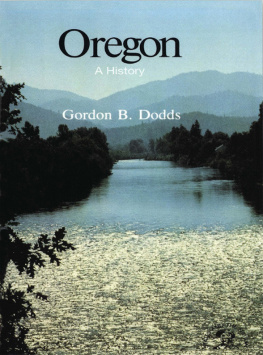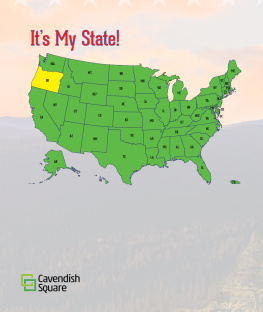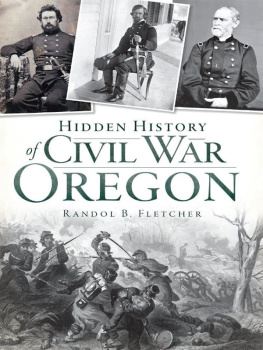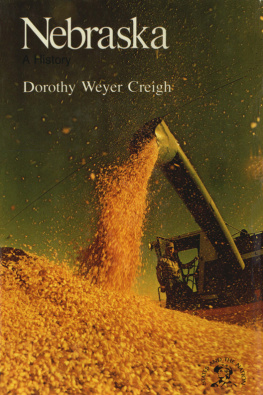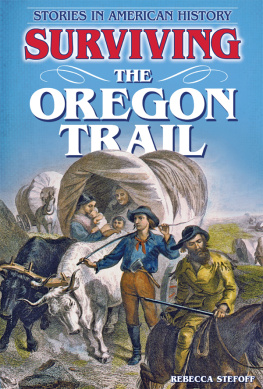Oregon
Library of Congress Cataloguing-in-Publication Data
Dodds, Gordon Barlow, 1932
Oregon: a bicentennial history.
(The States and the Nation series)
Bibliography: p.
Includes index.
1. OregonHistory. 1. Title. 11. Series.
F876.D6 979.5 779080
ISBN 978-0-393-34864-4 (e-book)
Copyright 1977
American Association for State and Local History
All rights reserved
Published and distributed by W.W. Norton & Company, Inc.
500 Fifth Avenue
New York, New York 10036
THE STATES AND THE NATION SERIES, of which this volume is a part, is designed to assist the American people in a serious look at the ideals they have espoused and the experiences they have undergone in the history of the nation. The content of every volume represents the scholarship, experience. and opinions of its author. The costs of writing and editing were met mainly by grants from the National Endowment for the Humanities, a federal agency. The project was administered by the American Association for State and Local History, a nonprofit learned society, working with an Editorial Board of distinguished editors, authors, and historians, whose names are listed below.

EDITORIAL ADVISORY BOARD
James Morton Smith, General Editor
Director, State Historical Society
of Wisconsin
William T. Alderson, Director
American Association for
State and Local History
Roscoe C. Born
Vice-Editor
The National Observer
Vernon Carstensen
Professor of History
University of Washington
Michael Kammen, Professor of
American History and Culture
Cornell University
Louis L.Tucker
President (19721974)
American Association for
State and Local History
Joan Paterson Kerr
Consulting Editor
American Heritage
Richard M. Ketchum
Editor and Author
Dorset, Vermont
A. Russell Mortensen
Assistant Director
National Park Service
Lawrence W. Towner
Director and Librarian
The Newberry Library
Richmond D. Williams
President (19741976)
American Association for
State and Local History
MANAGING EDITOR
Gerald George
American Association for
State and Local History
Contents
Illustrations
Although there is no one-volume history of Oregon in print, substantial portions of three excellent works dealing with larger areas survey the history of the state. The best interpretation of the Pacific Northwest is Dorothy O. Johansen and Charles Gates, Empire of the Columbia: A History of the Pacific Northwest (2d ed. New York: Harper and Row, 1967), a work that integrates regional, national, and international developments. Earl S. Pomeroy, The Pacific Slope: A History of California, Oregon, Washington, Idaho, Utah, and Nevada (New York: Alfred A. Knopf, 1965), is brilliant and well-written. David S. Lavender, in Land of Giants: The Drive to the Pacific Northwest, 17501950 (Garden City, N.Y.: Doubleday, 1958), emphasizes heroic deeds and great men and women, particularly those of the nineteenth century.
For the Indians, Ella E. Clark, Indian Legends of the Pacific Northwest (Berkeley and Los Angeles: University of California Press, 1953), is a compilation of the Indians views of men and nature. In the splendid novel Trask (New York: Viking Press, 1960), Don Berry deals with many of the same themes and their conflict with the values of the Caucasians. A superb account of an important tribe from the precontact era to the 1960s is Theodore Stern, The Klamath Tribe: A People and Their Reservation (Seattle: University of Washington Press, 1965), which traces the impact of white attitudes and policies upon the Indian culture.
Among the host of works on the period of exploration and the fur trade are Lavenders Land of Giants (cited above) and three other works. Stewart H. Holbrook in his smoothly written work, The Columbia (New York: Rinehart, 1956), talks of the explorers in a colorful vein. John E. Bakeless is equally interesting in his dual biography, Lewis and Clark, Partners in Discovery (New York: Morrow, 1947). Warren L. Cooks magisterial Flood Tide of Empire: Spain and the Pacific Northwest, 15431819 (New Haven: Yale University Press, 1973) also gives detailed treatment of the Russian, British, and American interests in the region. The most interesting account of Astors venture is Gabriel Franchre, Journal of a Voyage on the North West Coast of North America, ed. W. Kaye Lamb (Toronto: The Champlain Society, 1969), written by a participant in the events who wrote clearly and vividly.
The life of the American pioneers is captured in A. B. Guthrie, The Way West (New York: Sloane, 1949), a fictional account of the settlers reasons for going to Oregon and their adventures on the trail. Antebellum politics is the theme of Robert Johannsens detailed Frontier Politics and the Sectional Conflict: The Pacific Northwest on the Eve of the Civil War (Seattle: University of Washington, 1955). Economic life of the times is carefully described in Arthur L. Throckmortons Oregon Argonauts: Merchant Adventurers on the Western Frontier (Portland: Oregon Historical Society, 1961).
For postCivil War cultural and economic life there are several outstanding works. James B. Hedges makes clear the intricacies of railroad building in his Henry Villard and the Railways of the Northwest (New Haven: Yale University Press, 1930). Donald W. Meinig deals lucidly with the central and eastern sections of Oregon (and Washington) in their changing patterns of land use in The Great Columbia Plain: A Historical Geography, 18051910 (Seattle: University of Washington Press, 1968). Malcolm Clark has provided a portrait of several features of Oregons society, especially that of Portland, in his annotated edition of Judge Deadys diaries, Pharisee Among Philistines: The Diary of Judge Matthew P. Deady, 18711892, 2 vols. (Portland: Oregon Historical Society, 1975). Harold L. Daviss picaresque novel, Honey in the Horn (New York: Harper, 1935), which won the Pulitzer Prize in 1936, describes Oregons economy and society in the early years of the twentieth century.
On more specialized topics, a splendid anthology is Thomas Vaughan and Virginia Guest Ferriday, eds., Space, Style and Structure: Building in Northwest America, 2 vols. (Portland: Oregon Historical Society, 1974), which goes beyond architecture to encompass many aspects of the daily life of the people. Twentieth-century politics is lucidly treated in Robert E. Burton, Democrats of Oregon: The Pattern of Minority Politics, 19001956 (Eugene: University of Oregon Press, 1970). A brief, recent, and interesting history of Portland is Thomas Vaughan and Terrence ODonnell, Portland: A Historical Sketch and Guide (Portland: Oregon Historical Society, 1976). Ken Kesey in Sometimes a Great Notion (New York: Viking, 1964) has given first-rate fictional treatment of a gyppo logging family in southwestern Oregon. A modern collection of essays on various aspects of Oregon history is Thomas Vaughan, ed., The Western Shore: Oregon Country Essays Honoring the American Revolution (Portland: Oregon Historical Society, 1975).



